Machine Learning for Prediction of Energy in Wheat Production
Abstract
1. Introduction
Literature Review
- How much energy is required to produce wheat in Estahban?
- Is it efficient to produce wheat regarding energy consumption?
- Which method has higher accuracy for prediction?
2. Materials and Methods
2.1. Data Collection and Processing
2.2. Selected Input for the Model
2.3. Support Vector Machine (SVM)
2.4. Least Square Support Vector Machine (LS-SVM) Model
2.5. Proximal Support Vector Machine (PSVM) Model
2.6. Extreme Learning Machine (ELM)
- Single-output multi-class classification.
- Multi-output multi-class classification.
- In this study, we use the first type, single-output multi-class classification.
2.7. Support Vector Regression
2.8. The Functions Used in ELM
- “sig” stands for Sigmoidal function.
- “sin” stands for Sine function.
- “hardlim” stands for Hardlim function.
- “tribas” stands for the trigonometric basis functions.
2.9. Using Kernels
2.10. Performance Measures
3. Results
3.1. The Pattern Used in Wheat Cultivation
3.1.1. ELM Method
3.1.2. Radial Basis SVR Method
4. Discussion
Application of the Developed Model in the Future
5. Conclusions
- To produce wheat in Estahban, 1,460,503.1 MJ of energy is required.
- From the obtained data, it is not energy efficient to produce wheat because 1,460,503.1 MJ energy is required to produce it, the total energy of which is 1,401,011.9 MJ. On the other hand, wheat is necessary for human beings.
- The extreme ELM model is capable of learning patterns and can forecast the energy output of the model with the lowest error.
Author Contributions
Funding
Acknowledgments
Conflicts of Interest
References
- Ewel, J.J.; Schreeg, L.A.; Sinclair, T.R. Resources for crop production: Accessing the unavailable. Trends Plant Sci. 2019, 24, 121–129. [Google Scholar] [CrossRef] [PubMed]
- Walls, H.; Baker, P.; Chirwa, E.; Hawkins, B. Food security, food safety & healthy nutrition: Are they compatible? Glob. Food Secur. 2019, 21, 69–71. [Google Scholar]
- Sakizadeh, M.; Zhang, C. Health risk assessment of nitrate using a probabilistic approach in groundwater resources of western part of Iran. Environ. Earth Sci. 2020, 79, 43. [Google Scholar] [CrossRef]
- Hosseinzadeh-Bandbafha, H.; Safarzadeh, D.; Ahmadi, E.; Nabavi-Pelesaraei, A. Optimization of energy consumption of dairy farms using data envelopment analysis—A case study: Qazvin city of Iran. J. Saudi Soc. Agric. Sci. 2018, 17, 217–228. [Google Scholar] [CrossRef]
- Rajabi, M.H.; Soltani, A.; Zeynali, E.; Soltani, E. Evaluation of Energy Use in Wheat Production in Gorgan. J. Plant Prod. (J. Agric. Sci. Nat. Resour.) 2012, 19, 143–171. [Google Scholar]
- Global Wheat Crop Condition Mostly Favorable: AMIS. Available online: https://www.graincentral.com/markets/global-wheat-crop-condition-mostly-favourable-amis/ (accessed on 14 July 2019).
- World Wheat Crop Set for Rebound: AMIS. Available online: https://www.graincentral.com/markets/world-wheat-crop-set-for-rebound-amis/ (accessed on 14 July 2019).
- Agricultural Statistics for 2015–2016 Crop Year. Available online: https://www.maj.ir/Dorsapax/userfiles/Sub65/Amarnamehj193-94.pdf (accessed on 24 October 2019).
- Commodity Intelligence Report. Available online: https://ipad.fas.usda.gov/highlights/2008/05/Iran_may2008.htm (accessed on 17 November 2019).
- Focus on Iran. Available online: https://www.world-grain.com/articles/12752-focus-on-iran (accessed on 17 November 2019).
- GIEWS-Global Information and Early Warning System. Available online: http://www.fao.org/giews/countrybrief/country.jsp%3Fcode%3DIRN (accessed on 17 November 2019).
- Taki, M.; Mahmoudi, A.; Mobtaker, H.G.; Rahbari, H. Energy consumption and modeling of output energy with multilayer feed-forward neural network for corn silage in Iran. Agric. Eng. Int. CIGR J. 2012, 14, 93–101. [Google Scholar]
- Bansal, S.; Roy, S.; Larachi, F. Support vector regression models for trickle bed reactors. Chem. Eng. J. 2012, 207, 822–831. [Google Scholar] [CrossRef]
- Mitchell, T.M. Machine Learning; McGraw Hill: Burr Ridge, IL, USA, 1997; Volume 45, pp. 870–877. [Google Scholar]
- Memon, M.I.; Noonari, S.; Laghari, M.A.; Pathan, M.; Pathan, A.; Sial, S.A. Energy Consumption Pattern in Wheat Production in Sindh Pakistan. Energy 2015, 5, 63–77. [Google Scholar]
- Zangeneh, M.; Omid, M.; Akram, A. A comparative study on energy use and cost analysis of potato production under different farming technologies in Hamadan province of Iran. Energy 2010, 35, 2927–2933. [Google Scholar] [CrossRef]
- He, Q.; Jin, X.; Du, C.; Zhuang, F.; Shi, Z. Clustering in extreme learning machine feature space. Neurocomputing 2014, 128, 88–95. [Google Scholar] [CrossRef]
- Lei, Y.; Zhao, D.; Cai, H. Prediction of length-of-day using extreme learning machine. Geod. Geodyn. 2015, 6, 151–159. [Google Scholar] [CrossRef]
- Neumann, K.; Rolf, M.; Steil, J.J. Reliable integration of continuous constraints into extreme learning machines. Int. J. Uncertain. Fuzziness Knowl. Based Syst. 2013, 21 (Suppl. S02), 35–50. [Google Scholar] [CrossRef]
- Nath, B.; Dhakre, D.S.; Bhattacharya, D. Forecasting wheat production in India: An ARIMA modelling approach. J. Pharmacogn. Phytochem. 2019, 8, 2158–2165. [Google Scholar]
- Haider, S.A.; Naqvi, S.R.; Akram, T.; Umar, G.A.; Shahzad, A.; Sial, M.R.; Khaliq, S.; Kamran, M. LSTM neural network based forecasting model for wheat production in Pakistan. Agronomy 2019, 9, 72. [Google Scholar] [CrossRef]
- Santamaría-Artigas, A.E.; Franch, B.; Guillevic, P.; Roger, J.C.; Vermote, E.F.; Skakun, S. Evaluation of Near-Surface Air Temperature From Reanalysis Over the United States and Ukraine: Application to Winter Wheat Yield Forecasting. IEEE J. Sel. Top. Appl. Earth Obs. Remote Sens. 2019, 12, 2260–2269. [Google Scholar] [CrossRef]
- Shelia, V.; Hansen, J.; Sharda, V.; Porter, C.; Aggarwal, P.; Wilkerson, C.J.; Hoogenboom, G. A multi-scale and multi-model gridded framework for forecasting crop production, risk analysis, and climate change impact studies. Environ. Model. Softw. 2019, 115, 144–154. [Google Scholar] [CrossRef]
- Yazdani, M. The Economic and Statistical Evaluation of Climatic Elements in Tabriz and Isfahan (in Iran). J. Bus. Manag. Econ. Res. 2019, 3, 18. [Google Scholar] [CrossRef]
- Ram, B.; Rashid, M.; Lakhwani, K.; Kumar, S.S. Health Detection of Wheat Crop Using Pattern Recognition and Image Processing. Int. J. Healthc. Inf. Syst. Inform. (IJHISI) 2020, 15, 50–60. [Google Scholar] [CrossRef]
- Ali, M.; Deo, R.C. Modeling wheat yield with data-intelligent algorithms: Artificial neural network versus genetic programming and minimax probability machine regression. In Handbook of Probabilistic Models; Butterworth-Heinemann: Waltham, MA, USA, 2020; pp. 37–87. [Google Scholar]
- Salim, N.; Raza, A. Nutrient use efficiency (NUE) for sustainable wheat production: A review. J. Plant Nutr. 2020, 43, 297–315. [Google Scholar] [CrossRef]
- Kamir, E.; Waldner, F.; Hochman, Z. Estimating wheat yields in Australia using climate records, satellite image time series and machine learning methods. ISPRS J. Photogramm. Remote Sens. 2020, 160, 124–135. [Google Scholar] [CrossRef]
- Pantazi, X.E.; Moshou, D.; Alexandridis, T.; Whetton, R.L.; Mouazen, A.M. Wheat yield prediction using machine learning and advanced sensing techniques. Comput. Electron. Agric. 2016, 121, 57–65. [Google Scholar] [CrossRef]
- Amato, F.; Castiglione, A.; Moscato, V.; Picariello, A.; Sperli, G. Multimedia summarization using social media content. Multimed. Tools Appl. 2018, 77, 17803–17827. [Google Scholar] [CrossRef]
- Wang, D.; Zhan, Y.; Yu, T.; Liu, Y.; Jin, X.; Ren, X.; Chen, X.; Liu, Q. Improving Meteorological Input for Surface Energy Balance System Utilizing Mesoscale Weather Research and Forecasting Model for Estimating Daily Actual Evapotranspiration. Water 2020, 12, 9. [Google Scholar] [CrossRef]
- Yousefi, M.; Khoshnevisan, B.; Shamshirband, S.; Motamedi, S.; Nasir, M.H.; Arif, M.; Ahmad, R. Support vector regression methodology for prediction of output energy in rice production. Stoch. Environ. Res. Risk Assess. 2015, 29, 2115–2126. [Google Scholar] [CrossRef]
- Acaroğlu, M.; Aksoy, A.Ş. The cultivation and energy balance of Miscanthus× giganteus production in Turkey. Biomass Bioenergy 2005, 29, 42–48. [Google Scholar] [CrossRef]
- Esengun, K.; Erdal, G.; Gündüz, O.; Erdal, H. An economic analysis and energy use in stake-tomato production in Tokat province of Turkey. Renew. Energy 2007, 32, 1873–1881. [Google Scholar] [CrossRef]
- Singh, J.M. On Farm Energy Use Pattern in Different Cropping Systems in Haryana, India. Master’s Thesis, International Institute of Management, University of Flensburg, Flensburg, Germany, 2002. [Google Scholar]
- Canakci, M.; Topakci, M.; Akinci, I.; Ozmerzi, A. Energy use pattern of some field crops and vegetable production: Case study for Antalya Region, Turkey. Energy Convers. Manag. 2005, 46, 655–666. [Google Scholar] [CrossRef]
- Ozkan, B.; Akcaoz, H.; Fert, C. Energy input–output analysis in Turkish agriculture. Renew. Energy 2004, 29, 39–51. [Google Scholar] [CrossRef]
- Erdal, G.; Esengün, K.; Erdal, H.; Gündüz, O. Energy use and economical analysis of sugar beet production in Tokat province of Turkey. Energy 2007, 32, 35–41. [Google Scholar] [CrossRef]
- Ozkan, B.; Akcaoz, H.; Karadeniz, F. Energy requirement and economic analysis of citrus production in Turkey. Energy Convers. Manag. 2004, 45, 1821–1830. [Google Scholar] [CrossRef]
- Deng, W.; Zheng, Q.; Chen, L. Regularized extreme learning machine. In 2009 IEEE Symposium on Computational Intelligence and Data Mining; IEEE: New York City, NY, USA, 2009; pp. 389–395. [Google Scholar]
- Huang, G.B.; Bai, Z.; Kasun, L.L.; Vong, C.M. Local receptive fields based extreme learning machine. IEEE Comput. Intell. Mag. 2015, 10, 18–29. [Google Scholar] [CrossRef]
- Kasun, L.L.; Yang, Y.; Huang, G.B.; Zhang, Z. Dimension reduction with extreme learning machine. IEEE Trans. Image Process. 2016, 25, 3906–3918. [Google Scholar] [CrossRef]
- Huang, G.B.; Zhou, H.; Ding, X.; Zhang, R. Extreme learning machine for regression and multiclass classification. IEEE Trans. Syst. Man Cybern. Part B 2012, 42, 513–529. [Google Scholar] [CrossRef]
- Alamili, M. Exchange Rate Prediction Using Support Vector Machines; Technische Universiteit Delft: Delft, The Netherlands, 2011. [Google Scholar]
- Smola, A.J.; Schölkopf, B. A tutorial on support vector regression. Stat. Comput. 2004, 14, 199–222. [Google Scholar] [CrossRef]
- Welling, M. Support Vector Regression; Department of Computer Science, University of Toronto: Toronto, ON, Canada, 2004. [Google Scholar]
- Jahangir, A.; Raeini, S.M.; Ziatabar, A.M. Comparison of artificial neural networks (ANN) simulation of rainfall-runoff process with HEC-HMS model in Kardeh watershed. J. Soil Water Conserv. 2008, 2, 72–84. [Google Scholar]
- Miche, Y.; Sorjamaa, A.; Bas, P.; Simula, O.; Jutten, C.; Lendasse, A. OP-ELM: Optimally pruned extreme learning machine. IEEE Trans. Neural Netw. 2010, 21, 158–162. [Google Scholar] [CrossRef]
- Panahi, M.; Gayen, A.; Pourghasemi, H.R.; Rezaie, F.; Lee, S. Spatial prediction of landslide susceptibility using hybrid support vector regression (SVR) and the adaptive neuro-fuzzy inference system (ANFIS) with various metaheuristic algorithms. Sci. Total Environ. 2020, 741, 139937. [Google Scholar] [CrossRef]
- Samadianfard, S.; Hashemi, S.; Kargar, K.; Izadyar, M.; Mostafaeipour, A.; Mosavi, A.; Nabipour, N.; Shamshirband, S. Wind speed prediction using a hybrid model of the multi-layer perceptron and whale optimization algorithm. Energy Rep. Energy Rep. 2020, 6, 1147–1159. [Google Scholar] [CrossRef]
- Mostafaeipour, A.; Goli, A.; Qolipour, M. Prediction of air travel demand using a hybrid artificial neural network (ANN) with Bat and Firefly algorithms: A case study. J. Supercomput. 2018, 74, 5461–5484. [Google Scholar] [CrossRef]
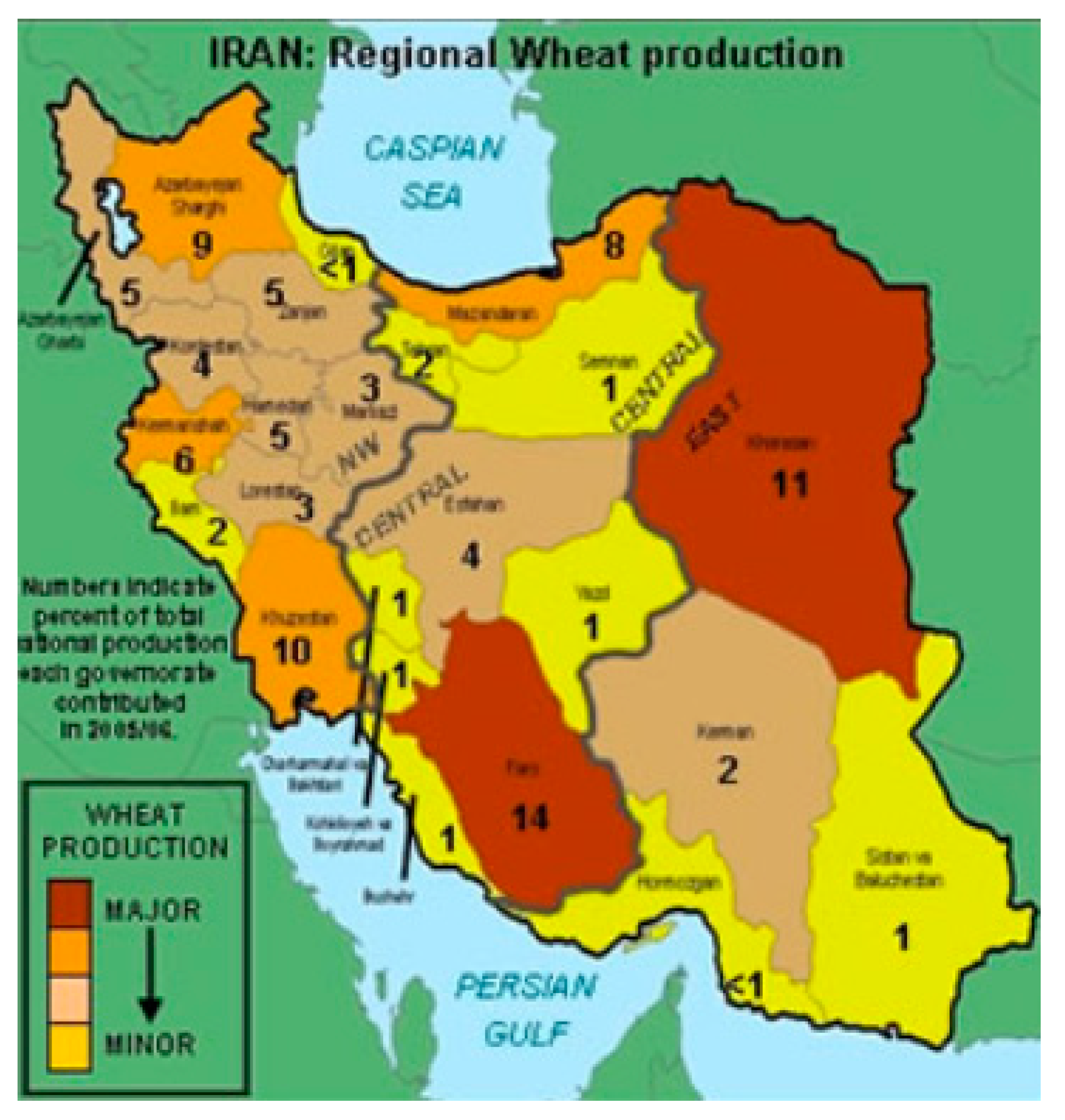

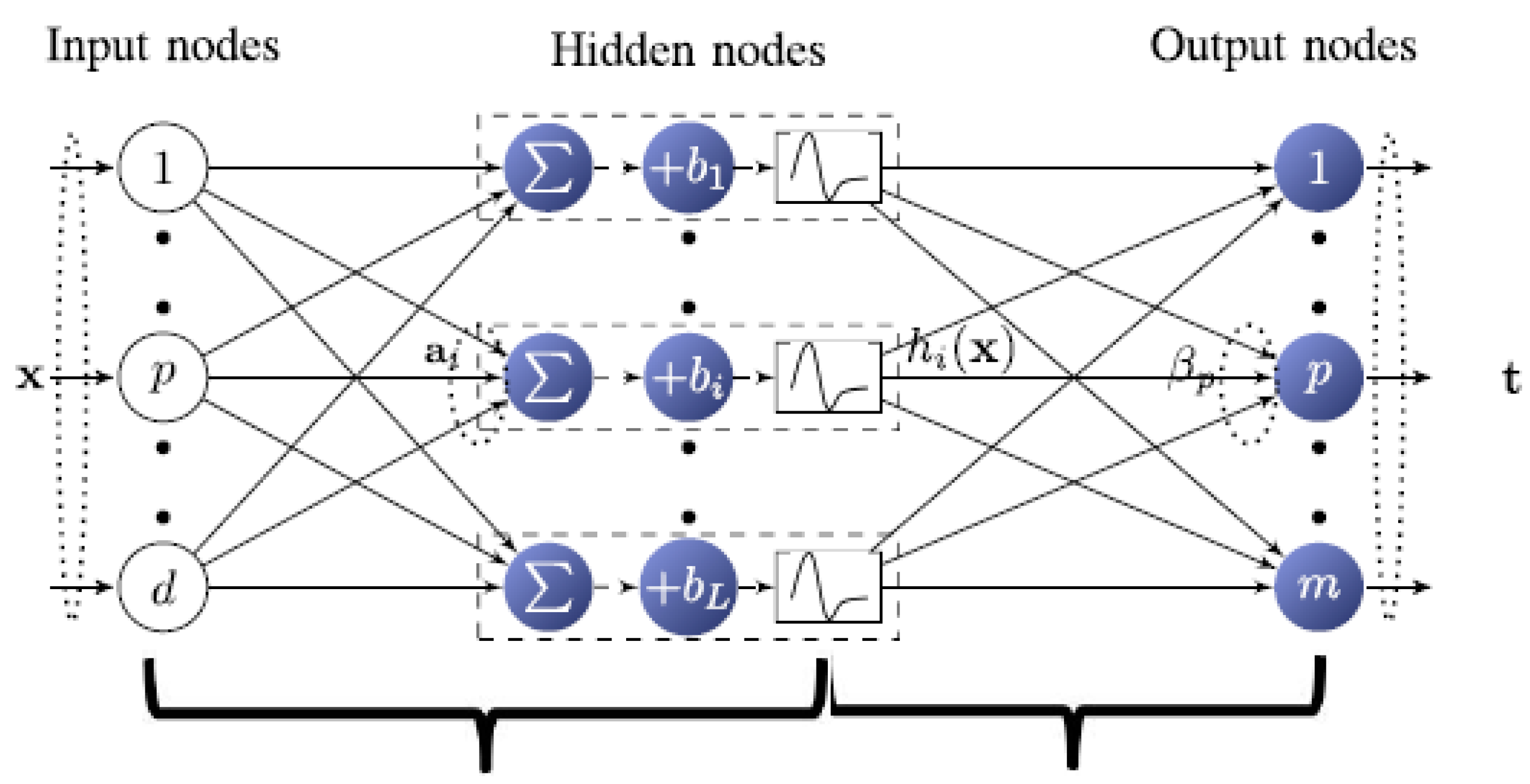

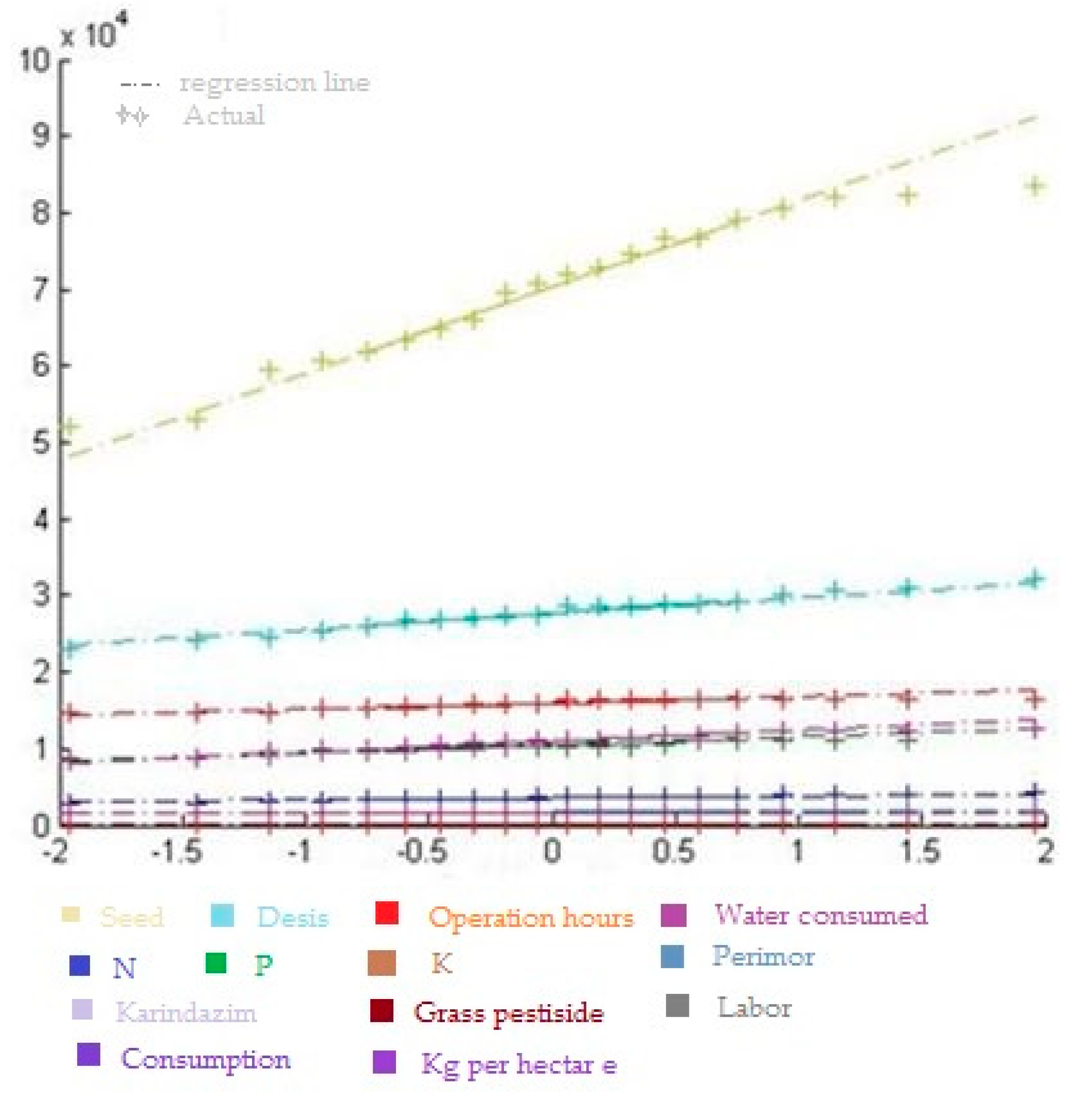
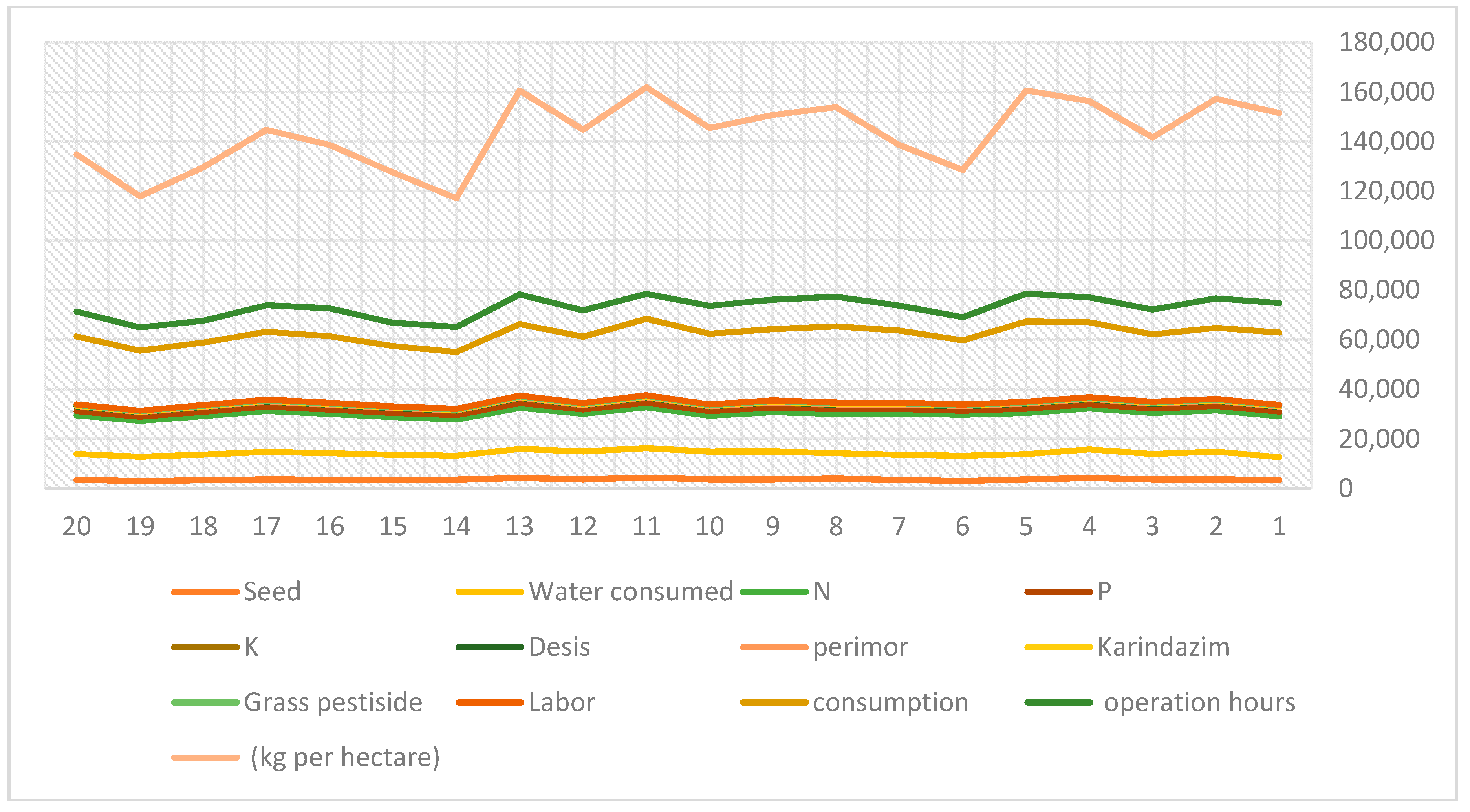
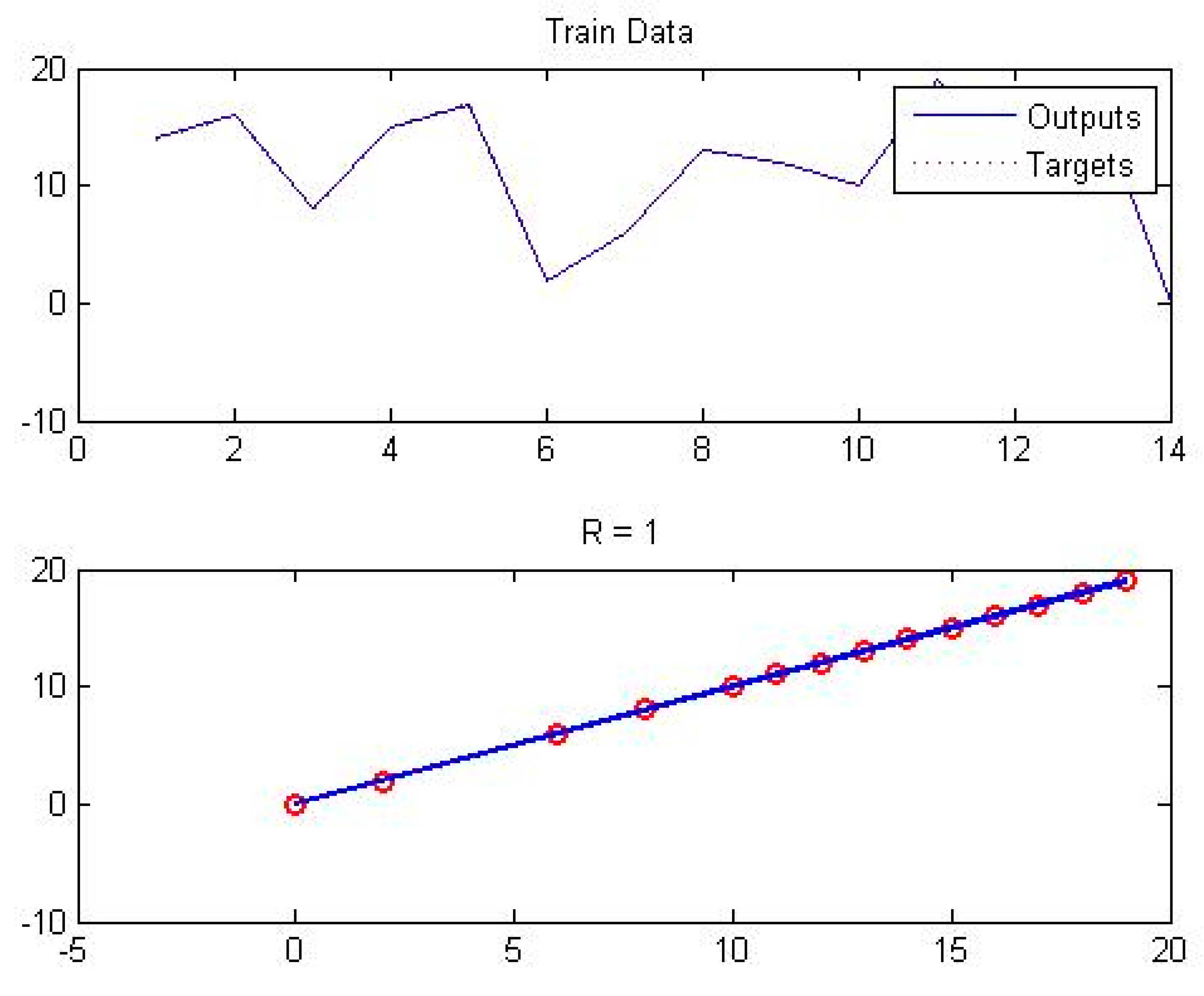
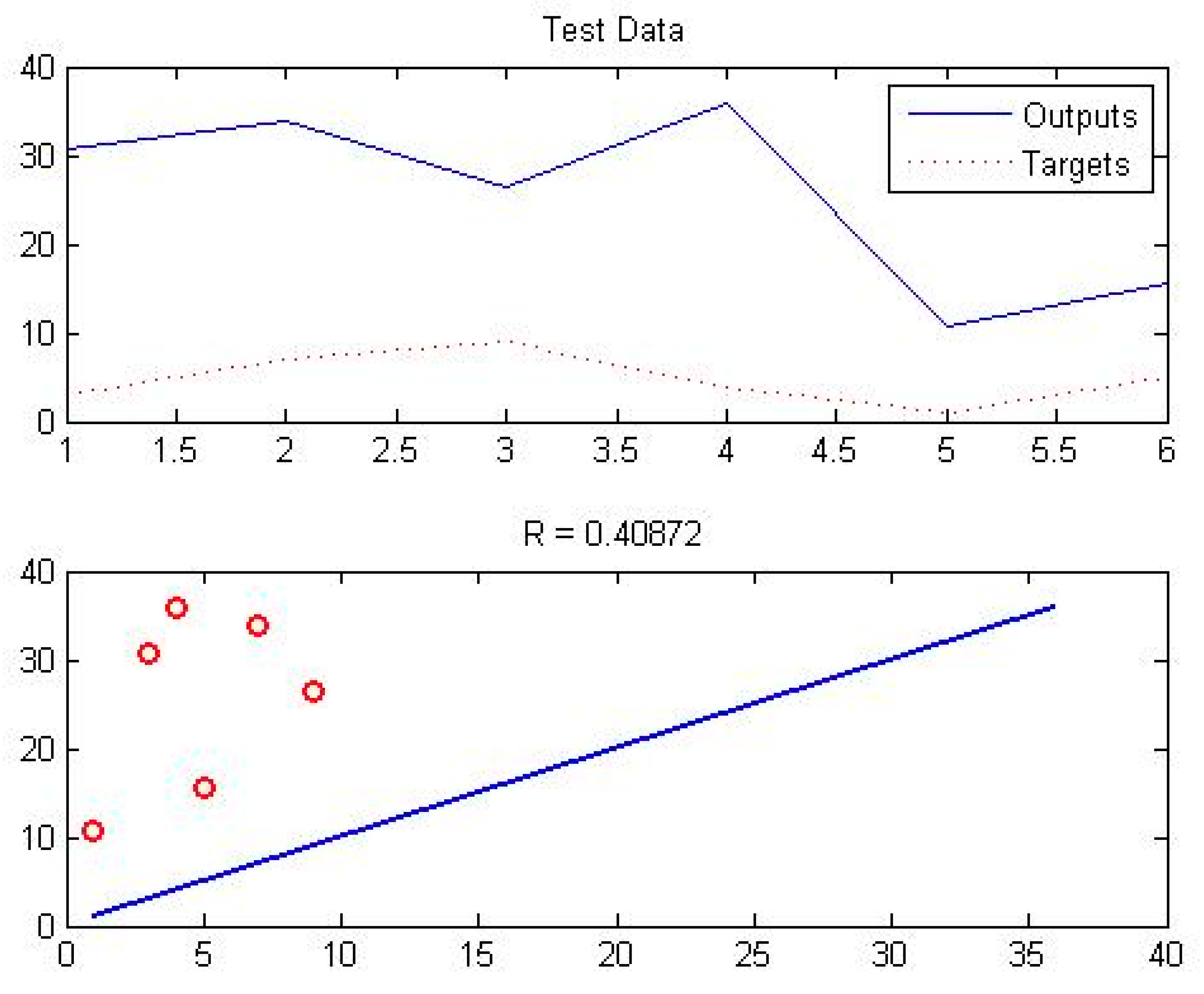
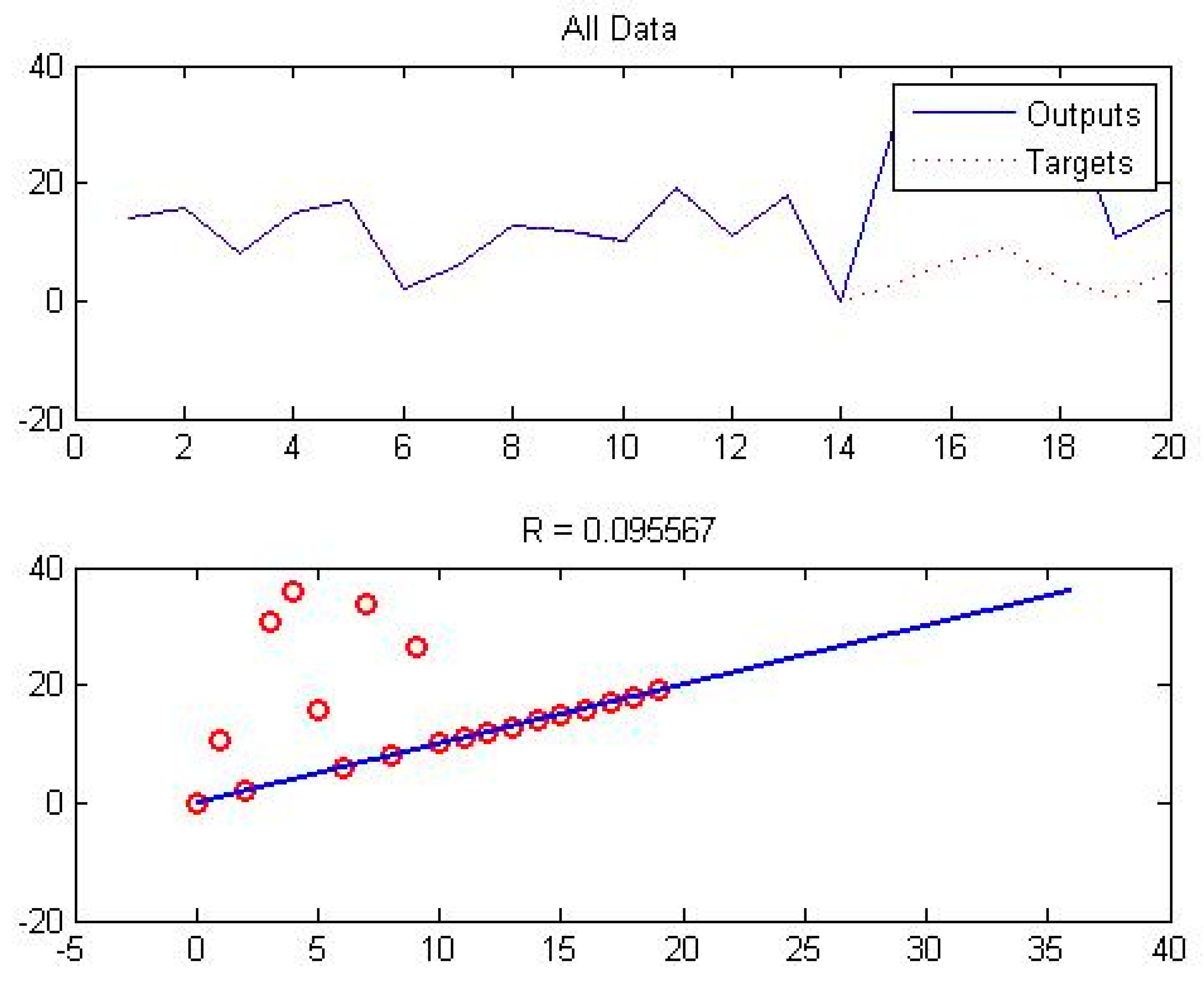
| Country | Average of 5 Years | 2018 Estim | 2019 Fcast |
|---|---|---|---|
| EU | 150.3 | 137.5 | 149.0 |
| China Mainland | 129.2 | 128.0 | 129.0 |
| India | 94.6 | 99.7 | 99.0 |
| USA | 54.6 | 51.3 | 52.0 |
| Russia | 70.5 | 72.1 | 79.0 |
| Australia | 23.3 | 17.3 | 24.0 |
| Canada | 30.2 | 31.8 | 33.0 |
| Pakistan | 25.8 | 25.5 | 24.5 |
| Turkey | 20.7 | 20.0 | 21.0 |
| Ukraine | 25.5 | 24.6 | 26.5 |
| Kazakhstan | 14.1 | 13.9 | 14.5 |
| Iran | 11.8 | 13.4 | 11.4 |
| Argentina | 16.3 | 19.5 | 19.0 |
| Egypt | 9.2 | 8.8 | 9.0 |
| Uzbekistan | 6.6 | 6.0 | 6.5 |
| Others | 59.6 | 59.0 | 58.0 |
| World | 742.3 | 728.3 | 757.4 |
| Cereal Production | 2014–2018 Average | 2018 | 2019 Forecast | Change 2019/2018 |
|---|---|---|---|---|
| Wheat | 11,820 | 13,400 | 13,400 | 0.0 |
| Barley | 2993 | 2800 | 3000 | 7.1 |
| Rice (paddy) | 2737 | 3020 | 3020 | 0.0 |
| Others | 1239 | 914 | 1125 | 22.0 |
| Total | 18,789 | 18,789 | 20,535 | 2.0 |
| Input/Output | Unit | Energy Equivalent (MJ/h) | Reference |
|---|---|---|---|
| Input | |||
| 1- Consumed water | M3 | 1.02 | [33] |
| 2- Chemical fertilizers | Kg | ||
| Nitrogen | 66.14 | [34] | |
| Phosphate | 12.55 | [34] | |
| Potassium | 11.15 | [34] | |
| 3- Pesticides | Kg | ||
| Decis | 120 | [35,36] | |
| Carbendazim | 120 | [35,36] | |
| Pirimor | 120 | [35,36] | |
| Herbicide | 120 | ||
| 4- Labor | h | 1.96 | [37] |
| 5- Diesel fuel | L | 56.31 | [35,38] |
| 6- Equipment and machines | h | 62.7 | [37] |
| Prepare Tractor and land | |||
| Fixed equipment | |||
| Tools and machinery | |||
| Combine | |||
| Pesticide Sprayer | |||
| Water pump | |||
| 7- Grain | kg | 14.7 | [39] |
| Output | |||
| 8- Wheat | kg | 14.7 | [39] |
| Input | Unit | Average Consumed Energy | Percentage of Total Consumed Energy |
|---|---|---|---|
| Consumed water | m3 | 10,638.60 | 14.568% |
| Chemical fertilizers | |||
| Nitrogen | Kg | 15,906.67 | 21.782% |
| Phosphate | Kg | 1783.90 | 2.443% |
| Potassium | Kg | 1873.20 | 2.565% |
| Pesticides | |||
| Decis | Kg | 43.740 | 0.060% |
| Carbendazim | Kg | 235.200 | 0.322% |
| Pirimor | Kg | 120.000 | 0.164% |
| Herbicide | Kg | 172.80 | 0.237% |
| Labor | h | 299.39 | 0.410% |
| Diesel fuel | L | 27,772.23 | 38.031% |
| Equipment and machines | h | 10,596.30 | 14.510% |
| Grain | Kg | 3583.13 | 4.907% |
| Input | Unit | Total Energy |
| Total input energy (consumed) | MJ | 1,460,503.1 |
| Output | ||
| Output energy (produced wheat) | MJ | 1,401,011.945 |
| Method | Train | Test | ||||||
|---|---|---|---|---|---|---|---|---|
| R2 | R | RMSE | MSE | R2 | R | RMSE | MSE | |
| SVR | 1 | 1 | 4.6088 × 10−12 | 2.1241 × 10−23 | 0.167052 | 0.40872 | 22.4384 | 503.4801 |
| ELM | 0.9623 | 0.981 | 0.0895 | 0.008 | 0.9531 | 0.9763 | 0.1010 | 0.0102 |
Publisher’s Note: MDPI stays neutral with regard to jurisdictional claims in published maps and institutional affiliations. |
© 2020 by the authors. Licensee MDPI, Basel, Switzerland. This article is an open access article distributed under the terms and conditions of the Creative Commons Attribution (CC BY) license (http://creativecommons.org/licenses/by/4.0/).
Share and Cite
Mostafaeipour, A.; Fakhrzad, M.B.; Gharaat, S.; Jahangiri, M.; Dhanraj, J.A.; Band, S.S.; Issakhov, A.; Mosavi, A. Machine Learning for Prediction of Energy in Wheat Production. Agriculture 2020, 10, 517. https://doi.org/10.3390/agriculture10110517
Mostafaeipour A, Fakhrzad MB, Gharaat S, Jahangiri M, Dhanraj JA, Band SS, Issakhov A, Mosavi A. Machine Learning for Prediction of Energy in Wheat Production. Agriculture. 2020; 10(11):517. https://doi.org/10.3390/agriculture10110517
Chicago/Turabian StyleMostafaeipour, Ali, Mohammad Bagher Fakhrzad, Sajad Gharaat, Mehdi Jahangiri, Joshuva Arockia Dhanraj, Shahab S. Band, Alibek Issakhov, and Amir Mosavi. 2020. "Machine Learning for Prediction of Energy in Wheat Production" Agriculture 10, no. 11: 517. https://doi.org/10.3390/agriculture10110517
APA StyleMostafaeipour, A., Fakhrzad, M. B., Gharaat, S., Jahangiri, M., Dhanraj, J. A., Band, S. S., Issakhov, A., & Mosavi, A. (2020). Machine Learning for Prediction of Energy in Wheat Production. Agriculture, 10(11), 517. https://doi.org/10.3390/agriculture10110517







